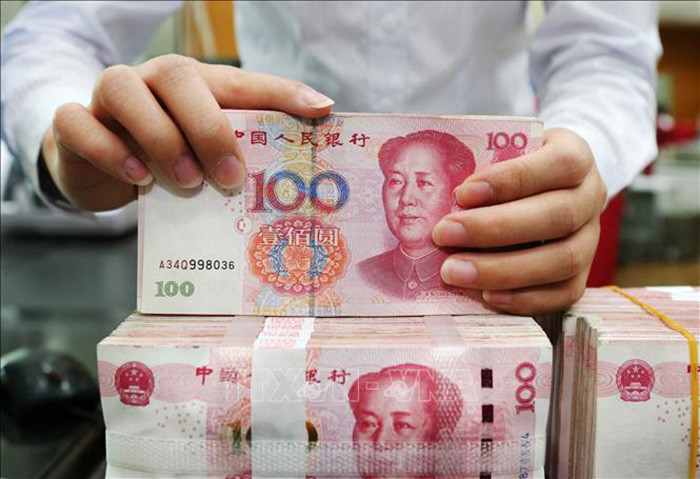Many countries have adopted the yuan in trade and commerce. Russia, Iran, Brazil, Argentina and Bangladesh are pioneers in this development.

A bank employee checks 100 yuan notes in Jiangsu province, China. Photo: AFP/VNA
The majority of global trade is done in the US dollar, and this stems from the events at the end of World War II. In 1944, representatives of 44 countries gathered in Bretton Woods, New Hampshire, to find a way to restore the world economy after the war. The representatives agreed that the US, as the world's largest economy, would fix the value of the US dollar to gold and other countries would in turn fix their currencies to the greenback. Countries held US dollars in reserve to maintain their exchange rates, making it the dominant global currency.
The US’s deep and flexible financial markets, relatively transparent governance standards and the stability of the US dollar have ensured that the currency remains dominant. The dominance of the US dollar has weathered the storms of the European Union’s (EU) introduction of the euro in 1999 and the 2008-2009 financial crisis. Today, nearly 60% of foreign exchange reserves held by central banks around the world are in US dollars. However, experts also note that in 2000, this ratio was 70%. According to them, this is a small change in the global financial order.
Sanctions against Russia over the Ukraine conflict have prompted a number of world leaders and prominent business figures to warn about the power wielded by Washington. French President Emmanuel Macron has warned of “dollar extraterritoriality.” In an April interview with Politico, Macron said Europe should reduce its dependence on the greenback.
China's yuan is seizing the opportunity and becoming a challenge to the dominance of the US greenback.
According to Bloomberg Intelligence on April 26, last March, the yuan was used more than the USD in cross-border transactions for the first time.
US Treasury Secretary Janet Yellen acknowledged this, telling CNN in April: “There is a risk that when we use financial sanctions, they will tie the role of the dollar to that role and over time they may weaken the dollar. It is an effective tool. Of course, it also encourages China, Russia or Iran to find alternatives.” But Yellen also asserted that it would be difficult to recreate the ecosystem, such as the international payment infrastructure, that supports the dollar.
Here are 5 countries that have chosen the yuan for transactions:

Yuan at a bank in Jiangsu, China. Photo: AFP/TTXVN
Russia
The Russian economy has been hit hard by a series of sanctions. Russian banks have been kicked out of the Society for Worldwide Interbank Financial Telecommunication (SWIFT), an international payments system. SWIFT’s central role in international banking is often compared to Gmail’s role in email.
In addition, half of Russia's $640 billion in foreign exchange reserves have been frozen, forcing Russia to find alternative currencies to use in international transactions.
The yuan has emerged as a leading contender. Russia’s central bank said on April 10 that it bought 41.9 billion rubles ($538 million) worth of yuan in March, three times the 11.6 billion rubles in February.
Also according to the Russian central bank, in the country's foreign exchange market, ruble-yuan transactions account for 39% of total volume, surpassing the 34% of ruble-USD.
Brazil
Business Insider (USA) reported that Brazilian President Luiz Inacio Lula da Silva is one of the politicians who proposed the establishment of an alternative trade payment currency. He even called on the countries of the world's leading emerging economies (BRICS) Brazil, Russia, India, China and South Africa to move away from the USD.
Brazil's central bank has been quick to buy yuan. By the end of 2022, the yuan will surpass the euro as the second-largest currency in Brazil's foreign exchange reserves.
According to the announcement of the Brazilian Trade and Investment Promotion Agency on March 29, the country's Banco BOCOM BBM bank has reached an agreement with China to allow direct transactions between the real and the yuan instead of using the USD as the default currency.
The agency said the aim was to “reduce the cost of trade transactions” with direct exchange between the real and the yuan.
Not only the yuan, President Lula da Silva also proposed that BRICS countries establish a common currency for transactions.
Bangladesh
Bangladesh agreed in April to pay Russia for the construction of a nuclear power plant in yuan. Bloomberg (USA) reported on April 18 that the Russian Nuclear Energy Corporation (Rosatom) is the unit building the nuclear power plant in Bangladesh. Initially, Rosatom requested payment in rubles, but later the two countries agreed to use yuan.
Argentina
Argentina said on April 26 that it would pay for goods imported from China in yuan instead of dollars. Argentine Economy Minister Sergio Massa confirmed this information.
The yuan payment program began in April, with Argentina aiming to pay for $1 billion worth of Chinese imports in yuan. The South American country will then pay for about $790 million worth of monthly imports in yuan.
Iran
Like Russia, Iranian banks have been banned from SWIFT since 2018, forcing Tehran to find alternative payment systems. In February, Iran and China discussed increasing the use of the yuan and Tehran's rial for bilateral trade.
According to Tin Tuc Newspaper